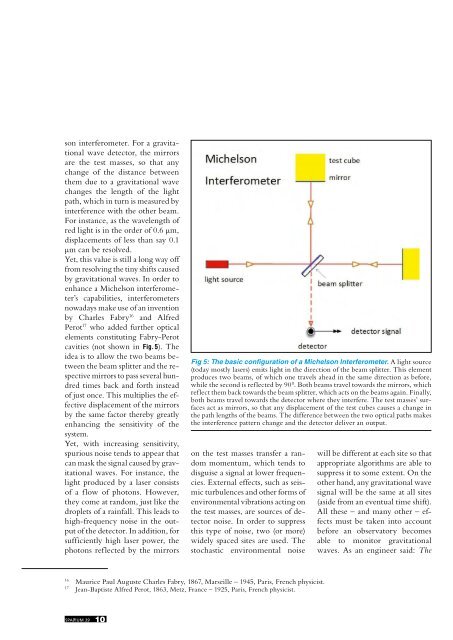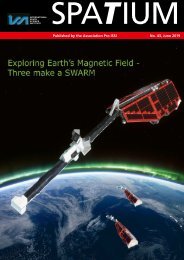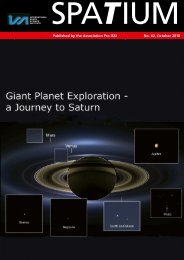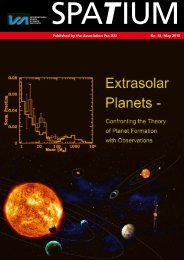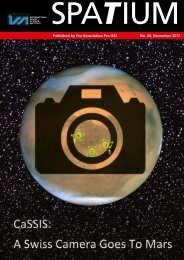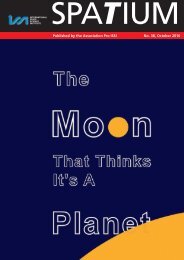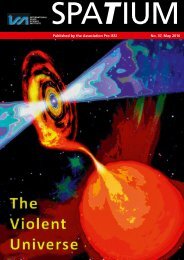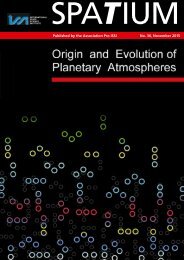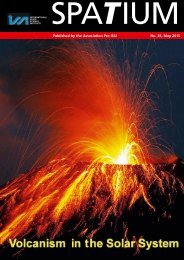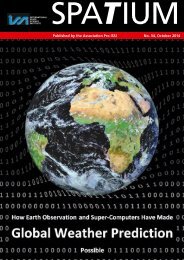Gravitational Waves - The Sound of the Dark Universe
Summary of the Pro ISSI talk by Karsten Danzmann (edited by H.Schlaepfer)
Summary of the Pro ISSI talk by Karsten Danzmann (edited by H.Schlaepfer)
- No tags were found...
You also want an ePaper? Increase the reach of your titles
YUMPU automatically turns print PDFs into web optimized ePapers that Google loves.
son interferometer. For a gravitational<br />
wave detector, <strong>the</strong> mirrors<br />
are <strong>the</strong> test masses, so that any<br />
change <strong>of</strong> <strong>the</strong> distance between<br />
<strong>the</strong>m due to a gravitational wave<br />
changes <strong>the</strong> length <strong>of</strong> <strong>the</strong> light<br />
path, which in turn is measured by<br />
interference with <strong>the</strong> o<strong>the</strong>r beam.<br />
For instance, as <strong>the</strong> wavelength <strong>of</strong><br />
red light is in <strong>the</strong> order <strong>of</strong> 0.6 µm,<br />
displacements <strong>of</strong> less than say 0.1<br />
µm can be resolved.<br />
Yet, this value is still a long way <strong>of</strong>f<br />
from resolving <strong>the</strong> tiny shifts caused<br />
by gravitational waves. In order to<br />
enhance a Michelson interferometer’s<br />
capabilities, interferometers<br />
nowadays make use <strong>of</strong> an invention<br />
by Charles Fabry 16 and Alfred<br />
Perot 17 who added fur<strong>the</strong>r optical<br />
elements constituting Fabry-Perot<br />
cavities (not shown in Fig. 5). <strong>The</strong><br />
idea is to allow <strong>the</strong> two beams between<br />
<strong>the</strong> beam splitter and <strong>the</strong> respective<br />
mirrors to pass several hundred<br />
times back and forth instead<br />
<strong>of</strong> just once. This multiplies <strong>the</strong> effective<br />
displacement <strong>of</strong> <strong>the</strong> mirrors<br />
by <strong>the</strong> same factor <strong>the</strong>reby greatly<br />
enhancing <strong>the</strong> sensitivity <strong>of</strong> <strong>the</strong><br />
system.<br />
Yet, with increasing sensitivity,<br />
spurious noise tends to appear that<br />
can mask <strong>the</strong> signal caused by gravitational<br />
waves. For instance, <strong>the</strong><br />
light produced by a laser consists<br />
<strong>of</strong> a flow <strong>of</strong> photons. However,<br />
<strong>the</strong>y come at random, just like <strong>the</strong><br />
droplets <strong>of</strong> a rainfall. This leads to<br />
high-frequency noise in <strong>the</strong> output<br />
<strong>of</strong> <strong>the</strong> detector. In addition, for<br />
sufficiently high laser power, <strong>the</strong><br />
photons reflected by <strong>the</strong> mirrors<br />
Fig 5: <strong>The</strong> basic configuration <strong>of</strong> a Michelson Interferometer. A light source<br />
(today mostly lasers) emits light in <strong>the</strong> direction <strong>of</strong> <strong>the</strong> beam splitter. This element<br />
produces two beams, <strong>of</strong> which one travels ahead in <strong>the</strong> same direction as before,<br />
while <strong>the</strong> second is reflected by 90°. Both beams travel towards <strong>the</strong> mirrors, which<br />
reflect <strong>the</strong>m back towards <strong>the</strong> beam splitter, which acts on <strong>the</strong> beams again. Finally,<br />
both beams travel towards <strong>the</strong> detector where <strong>the</strong>y interfere. <strong>The</strong> test masses’ surfaces<br />
act as mirrors, so that any displacement <strong>of</strong> <strong>the</strong> test cubes causes a change in<br />
<strong>the</strong> path lengths <strong>of</strong> <strong>the</strong> beams. <strong>The</strong> difference between <strong>the</strong> two optical paths makes<br />
<strong>the</strong> interference pattern change and <strong>the</strong> detector deliver an output.<br />
on <strong>the</strong> test masses transfer a random<br />
momentum, which tends to<br />
disguise a signal at lower frequencies.<br />
External effects, such as seismic<br />
turbulences and o<strong>the</strong>r forms <strong>of</strong><br />
environmental vibrations acting on<br />
<strong>the</strong> test masses, are sources <strong>of</strong> detector<br />
noise. In order to suppress<br />
this type <strong>of</strong> noise, two (or more)<br />
widely spaced sites are used. <strong>The</strong><br />
stochastic environmental noise<br />
will be different at each site so that<br />
appropriate algorithms are able to<br />
suppress it to some extent. On <strong>the</strong><br />
o<strong>the</strong>r hand, any gravitational wave<br />
signal will be <strong>the</strong> same at all sites<br />
(aside from an eventual time shift).<br />
All <strong>the</strong>se – and many o<strong>the</strong>r – effects<br />
must be taken into account<br />
before an observatory becomes<br />
able to monitor gravitational<br />
waves. As an engineer said: <strong>The</strong><br />
16<br />
Maurice Paul Auguste Charles Fabry, 1867, Marseille – 1945, Paris, French physicist.<br />
17<br />
Jean-Baptiste Alfred Perot, 1863, Metz, France – 1925, Paris, French physicist.<br />
SPATIUM 39 10


